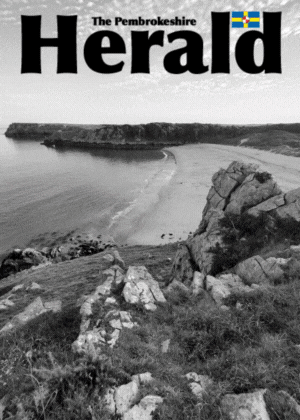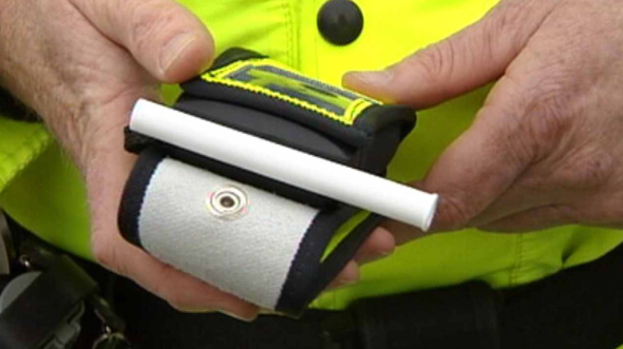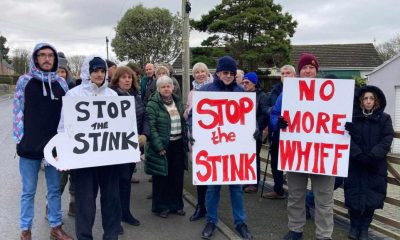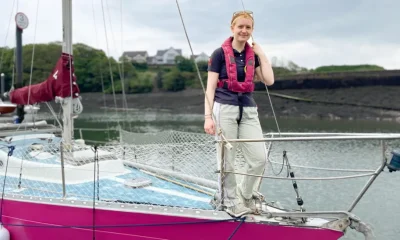Community
Treasure discovered from Bronze Age and Roman era in South Wales and Powys

FIVE treasure finds, including three hoards and two grave groups from the Bronze Age and Roman era, were declared as treasure on Tuesday 11th July 2023 by Patricia Morgan, the Area Coroner for South Wales Central.
A burial group from the Bronze Age consisting of a small gold penannular ring and fragments of a burnt wooden comb (Treasure Case 17.13) was unearthed by Rubicon Heritage Services (Red River Archaeology Group) during archaeological excavations in the St Nicholas and Bonvilston Community on 28th July 2017. The discovery was made as part of the archaeological work preceding the A4426 Five Mile Lane improvements road scheme, funded by the Welsh Government and executed by Cyngor Bro Morgannwg – Vale of Glamorgan Council. The two artifacts were found accompanying a human cremation burial in a small burial pit. The burial and the artifacts were meticulously recorded before being removed. A license was obtained from the Ministry of Justice, allowing the removal of the ancient human remains.
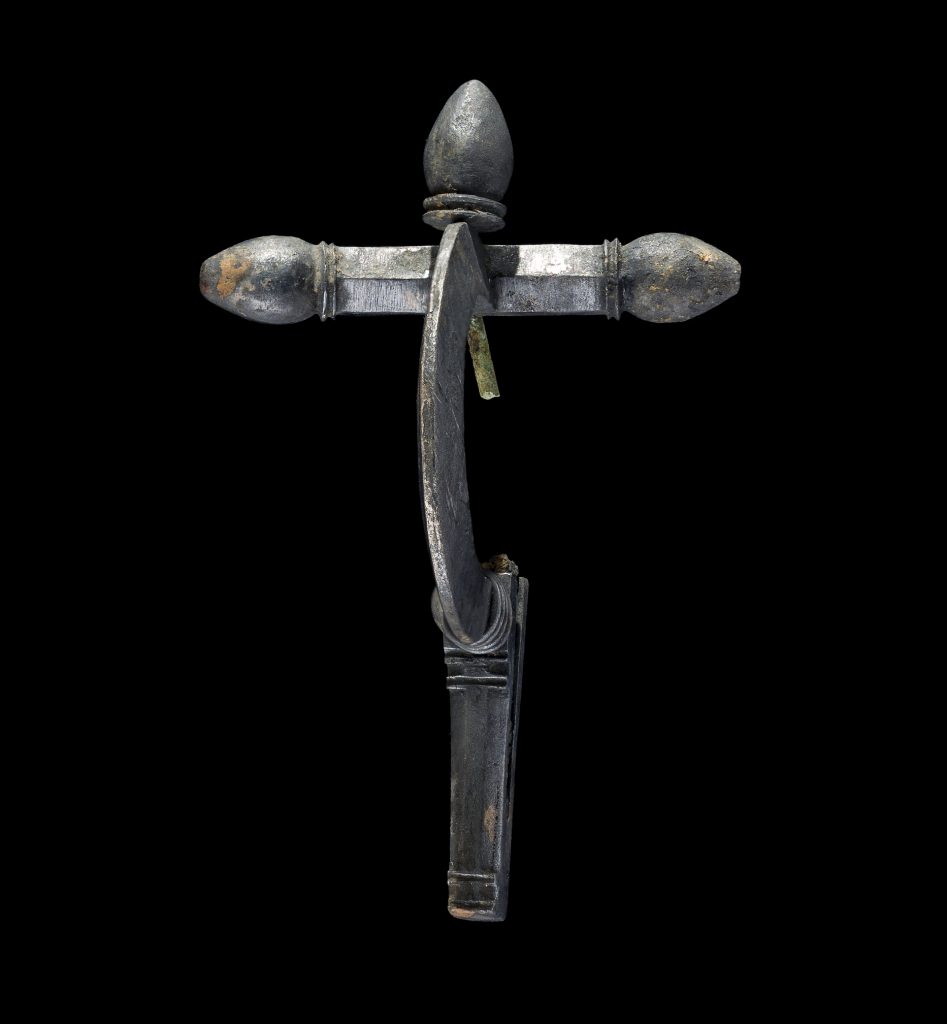
The gold penannular ring, measuring just 1.1cm in diameter, is a beautifully crafted piece decorated with a finely worked chevron or herringbone pattern. It represents an early example of a hair-ring, believed to have been used for hair decoration. The fragmentary wooden comb, with eight narrow and parallel teeth, is in a fragile state. It is an incredibly rare organic artifact that survived due to its charred state. These two objects, dating back to the Middle Bronze Age (1300-1150 BC), were carefully chosen as grave goods to accompany the deceased in the afterlife.
Adam Gwilt, the Principal Curator for Prehistory at Amgueddfa Cymru – Museum Wales, commented, “This cremation burial, with its accompanying gold ring and wooden comb, provides us with a glimpse into life and death during the Bronze Age. The gold ring is an early, well-crafted, and small example of its kind, offering new insights into the development of hair-rings as early forms of jewelry in Britain and Ireland. This grave is just one example of the wealth of prehistoric burial evidence being discovered across the Vale of Glamorgan, highlighting the richness, diversity, and significance of this archaeology and enhancing our understanding of the past.”
Amgueddfa Cymru – Museum Wales is interested in acquiring this discovery after an independent valuation by the Treasure Valuation Committee. The artifacts will become part of the broader collection and archive from this archaeological excavation, which is destined for the national collection.
David Gilbert, the Project Manager for Rubicon Heritage Services (Red River Archaeology Group), stated, “The gold ring is undoubtedly the most eye-catching object accompanying the cremation. However, the most important artifact is what may initially seem more mundane: the wooden comb. It is an unparalleled find in Wales, if not the UK. Together, these objects add a human element to our work, highlighting their significance to the person buried with them. They demonstrate the attention to detail and pride in appearance often missing from depictions of prehistoric people on television or in films. This discovery emphasizes the significant contribution made by commercial archaeology to advancing our detailed knowledge of the history of Wales.”
Another Roman burial was excavated by Rubicon Heritage Services (Red River Archaeology Group) in April 2017, as part of the archaeological work preceding the A4426 Five Mile Lane improvements road scheme, funded by the Welsh Government and executed by Cyngor Bro Morgannwg – Vale of Glamorgan Council. The burial included a silver crossbow brooch, the remains of an iron sword, and hobnails from a pair of shoes. This find underscores the valuable contribution of commercial archaeology in expanding our understanding of Wales’ history. The silver crossbow brooch, over 300 years old, falls under the remit of the Treasure Act (Treasure Case 17.06).
Crossbow brooches, a common type of Roman bow brooch, are predominantly made of copper alloy, although examples made of silver or gold exist. The sword discovered belongs to the longer type used by the Roman army in the third and fourth centuries AD, corresponding with the dating of the brooch.
Evan Chapman, the Senior Curator for Archaeology at Amgueddfa Cymru – Museum Wales, stated, “To the best of my knowledge, this is the first example of a Roman silver crossbow brooch found in Wales. Crossbow brooches appear to be associated with the late Roman army and civil service, possibly originally serving as badges of office. However, it has been suggested that elements of military dress, including crossbow brooches, were embraced by the wider elite. The presence of the sword supports the military connection in this case. Regardless of direct affiliation with the Roman army, the silver brooch indicates an individual of elite status.”
Amgueddfa Cymru – Museum Wales is interested in acquiring these objects following an independent valuation by the Treasure Valuation Committee. The artifacts will remain together with the rest of the finds from the excavations, which are already destined for the national collection.
Rachel Morgan, the Project Archaeologist for Rubicon Heritage Services (Red River Archaeology Group), remarked, “The burial of a young man in military attire was an unexpected discovery within a Roman field system. The silver crossbow brooch found with the individual signifies his important status within the military or wider society. His death occurred sometime between the mid-3rd to late 4th century, during which the brooch had become a symbol of imperial administrators. Therefore, he was unlikely to have been an ordinary soldier and evidently possessed significant wealth. Isotope analysis also revealed that he was not from the local area but likely grew up further east, possibly from the Welsh borders or beyond. The question arises: what was this wealthy man doing on a farm in south Wales when he died?”
A Bronze Age hoard of tools and weapons (Treasure Case 20.22) was discovered by Richard Griffiths on 17th December 2020 while using a metal detector in a boggy field in the Coychurch Higher Community, Bridgend. The hoard consists of seven bronze artifacts, including four fragmented socketed axes, a spearhead, a palstave, and a casting jet. Dating back to the Late Bronze Age (1000-800 BC), the hoard was originally buried in a small and isolated pit, likely as a religious offering to the gods. Relatively few hoards from this period are known in the uplands of south Wales, making this find crucial in enriching our knowledge of the people who lived in the area around 3,000 years ago.
An investigation of the findspot was carried out in August 2022 by a team from Amgueddfa Cymru and the Portable Antiquities Scheme Wales (PAS Cymru), with assistance from the finder.
Richard Griffiths, the metal detectorist who discovered the hoard, expressed his excitement, saying, “I was thrilled to find this Bronze Age hoard, and it’s truly special to know that my find is now a part of our shared history. To think that I was the first person to hold these objects since the last person who used them, thousands of years ago, is a remarkable feeling. I enjoyed being involved with the museum archaeologists during their geophysics work and the small dig. It was fascinating to see how they carefully dug and recorded everything. The unexpected discovery of the buried spearhead added another interesting twist to the story!”
Chris Griffiths, a researcher at Amgueddfa Cymru, who led the investigation of the findspot, commented, “The opportunity to study the location of this hoard was invaluable, and we are extremely grateful for the cooperation of the landowner and Richard throughout this process. The discovery of a bronze spearhead during the investigation was the ‘icing on the cake,’ providing us with fascinating insights into how Bronze Age people interacted with this upland landscape.”
Amgueddfa Cymru – Museum Wales is interested in acquiring this find after an independent valuation by the Treasure Valuation Committee.
David Howell, the Engagement Officer for the Portable Antiquities Scheme in Wales (PAS Cymru), stated, “For 25 years, the Portable Antiquities Scheme in Wales has been working to preserve knowledge and information about Welsh archaeology. During this time, PAS Cymru has recorded over 90,000 artifacts, establishing connections with the metal-detecting community and finders in general, to ensure that information about Welsh archaeology and history is recorded and shared with the nation.”
A Bronze Age hoard (Treasure Case 21.15) was discovered by Peter Anning while metal-detecting in a pasture field in the Pontprennau Community, Cardiff, on 30th October 2020. The hoard was initially reported to Mark Lodwick through the Portable Antiquities Scheme in Wales (PAS Cymru). It includes four fragments of a blade from a single leaf-shaped sword and two casting jets, which were generated during the casting of bronze artifacts in clay molds. The sword fragments belong to a type known as an Ewart Park sword, and one of the casting jets was created during the casting of a South Wales type socketed axe. These findings indicate that the hoard dates back to the Late Bronze Age, around 1000-800 BC. The artifacts were deliberately buried together in a small pit, most likely as a religious offering.
The Museum of Cardiff is interested in acquiring this hoard for its collection, pending an independent valuation by the Treasure Valuation Committee. The sword would be the museum’s first of its kind and a valuable addition to their Bronze Age archaeology collection, which already includes a socketed axe. The casting jets will contribute to the narrative surrounding the production of such axes in Bronze Age Cardiff. By acquiring this hoard, the museum will be able to expand their storytelling of this era and their collection from the Pontprennau area of Cardiff.
Chris Griffiths, a doctoral student at the University of Reading and Amgueddfa Cymru – Museum Wales, commented, “It is rare to find multiple joining pieces of swords from south Wales, making this hoard from Pontprennau Community, containing four blade fragments from a single sword, a significant new discovery. Prior to burial, the sword appears to have been deliberately broken into pieces, with some missing fragments possibly being recycled to create other objects. The way in which this sword was broken, combined with the presence of two casting jets, suggests the involvement of a local bronzesmith in creating this hoard, allowing us to imagine the lives of people who lived in this part of Cardiff around 3,000 years ago.”
A small hoard of Roman coins (Treasure Case 21.18) was found by Shawn Hendry and Chris Perkins in May 2021 while using metal detectors in a pasture field in the Glascwm Community, Powys. The coin group comprises six silver coins, known as denarii, ranging in date from 32 BC to AD 161. The coins feature representations of Mark Antony, as well as the emperors Titus, Hadrian, and Antoninus Pius. The latest coin in the group could have been minted as late as AD 161, indicating that the coins were likely lost together between AD 145 and 165. Most of the coins were in circulation for a long period before they were lost, and the earliest coin, belonging to Mark Antony (32-1 BC), is highly worn. The coins were probably lost as a small purse group or as a small hoard.
The Radnorshire Museum is interested in acquiring this hoard, following an independent valuation by the Treasure Valuation Committee.
Amgueddfa Cymru is a charity and a family of seven national museums and a collections center located across the country. The aim of the organization is to inspire everyone through Wales’ story, at the museums, in communities, and online. Admission is free, thanks to funding from the Welsh Government, and everyone is welcome.
To learn more about Amgueddfa Cymru’s seven museums, follow them on Twitter, Instagram, or Facebook.
Community
Further pleas to save Anchorage Say Centre
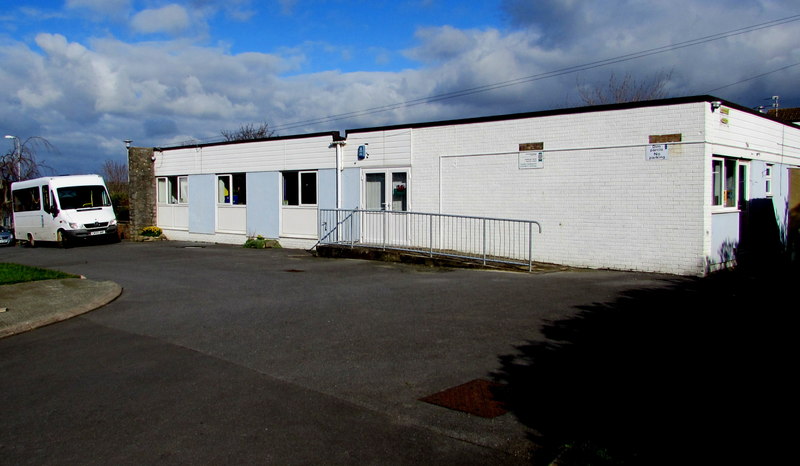
A PLEA by a concerned parent to keep Pembroke Dock’s Anchorage Day Centre open was heard at a full meeting of Pembrokeshire County Council.
The Anchorage Day Care Centre in Pembroke Dock has been a “safe and happy place” for adults with learning difficulties and additional needs for decades.
In more recent years it has expanded to support elderly dementia sufferers.
But now the centre is expected to close, with services instead being offered elsewhere in the county, including Haverfordwest and Milford Haven.
A series of engagement events have taken place at The Anchorage recently, outlining the reasons and the options in continued service.
One parent, who wished to remain anonymous, said: “One young woman who attends ran out of the first meeting sobbing when she was told it was going to close. Another, at the second meeting, tried to address the meeting but was so choked up at the thought of not seeing her friends anymore she could hardly speak.”
In a submitted question heard at the May 9 meeting of Pembrokeshire County Council, concerned parent Peter Welsh asked: “Is the council aware of the huge impact the impending closure of the Anchorage Adult Day-care Centre in Pembroke Dock is already having to the health and mental wellbeing of my daughter and 20 other vulnerable adults with special needs and learning difficulties, who are unable to cope with changes to routine, or to process and understand what is happening to them?
“And would the council, therefore, please review its closure decision and retain the centre and the vital and invaluable service it provides not only to the individuals concerned but also to the parents?
“If not, what specific measures does the cabinet member have in place to support my daughter and these other individuals who need extra assistance to enable them to maintain their independence, value and allow their carers to have valuable respite from their caring responsibilities and what are the estimated costs for these substitute measures?”
Responding, Cabinet Member for Social Care & Safeguarding Cllr Tessa Hodgson said an engagement with service users, carers and families was made immediately after staff were informed about the potential closure following the council’s March budget setting.
Members were told two sessions were held with all concerned, with a list of alternative day opportunities in the county outlined, with opportunities to attend short sessions at the other centres being available so they “can fully explore which opportunity is best suited to their needs and wants”.
“All service users of the Anchorage will be offered alternative day centre arrangements in order to preserve their independence and also to support the caring needs of their families, these assessments are still taking place and are likely to continue to do so at least until the end of May.”
Cllr Hodgson said she was unable to provide estimated costs of the new arrangements until all the assessments were in place, hoping to update members at a future date.
An online e-petition, on the council’s own website has been launched calling for the Anchorage to stay open.
Community
49 Welsh locations crowned among best beaches in the world

KEEP WALES TIDY has today announced the Wales Coast Award winners for 2024, spotlighting the 49 coastal sites achieving the high standards required to receive a prestigious Blue Flag, Green Coast or Seaside Award.
With more and more local authorities and organisations facing pressure on reduced budgets, it is heartening to see so many continue to prioritise the delivery of the exceptional standards required to achieve these awards in the stunning coastal areas which surround our beautiful country.
Blue Flag is managed internationally by FEE (the Foundation for Environmental Education) and is one of the world’s most recognised awards for beaches, marinas and boats. The programme’s mission is to promote environmental education, sustainable development of tourism, environmental management systems and ensure safety and access for beach users.
The 24 Welsh beaches achieving this accolade must adhere to specific criteria related not only to water quality, but also information provision, environmental education, safety, and site management in equal measure.
Alongside the 24 Blue Flag awards, 13 beaches in Wales were awarded the Green Coast Award which recognises their clean environment, excellent water quality and natural beauty. Green Coast Awards are ‘hidden gems’ along the Welsh coastline, exceptional places to visit and enjoy diversity and rich coastal heritage.
In addition, a total of 12 beaches, including Aberporth and Rhyl Central, also achieved the Seaside Award for the standard of their facilities and water quality.
This continued recognition of our stunning Welsh coastline is due once again to the huge effort of staff and volunteers at sites across Wales, and a shared drive to protect and preserve our natural landscape in the face of increasingly challenging circumstances.
Cabinet Secretary for Climate Change and Rural Affairs, Huw Irranca-Davies, said: “Wales boasts some of Europe’s finest beaches and water quality, and the global recognition of our coastline is a true reflection of the dedication and hard work of so many people, today we celebrate the announcement of 49 winners for the Wales Coast Awards 2024.
“With 24 Blue Flag awards, 13 Green Coast Awards, and 12 Seaside Awards, I commend the dedication to preserving our pristine coastal environments.
“As we celebrate in this achievement, let us also heed the call to protect and preserve our coastal treasures. Let’s ensure that we leave nothing but footprints, allowing these breathtaking spaces to be enjoyed for many generations to come.”
Owen Derbyshire, Keep Wales Tidy Chief Executive said: “We’re delighted to see another successful year of Coast Awards here in Wales, with 49 stunning locations recognised among the world’s best.
“Achieving these prestigious awards means meeting rigorous standards put in place to ensure the safe enjoyment of visitors now and in years to come. This success is testament to the hard work of all involved in maintaining and enhancing the natural beauty of our Welsh coastline.”
A full list of awards can be found on the Keep Wales Tidy website here
Community
Work to begin on Pembrokeshire’s ‘treacherous’ stretch of road
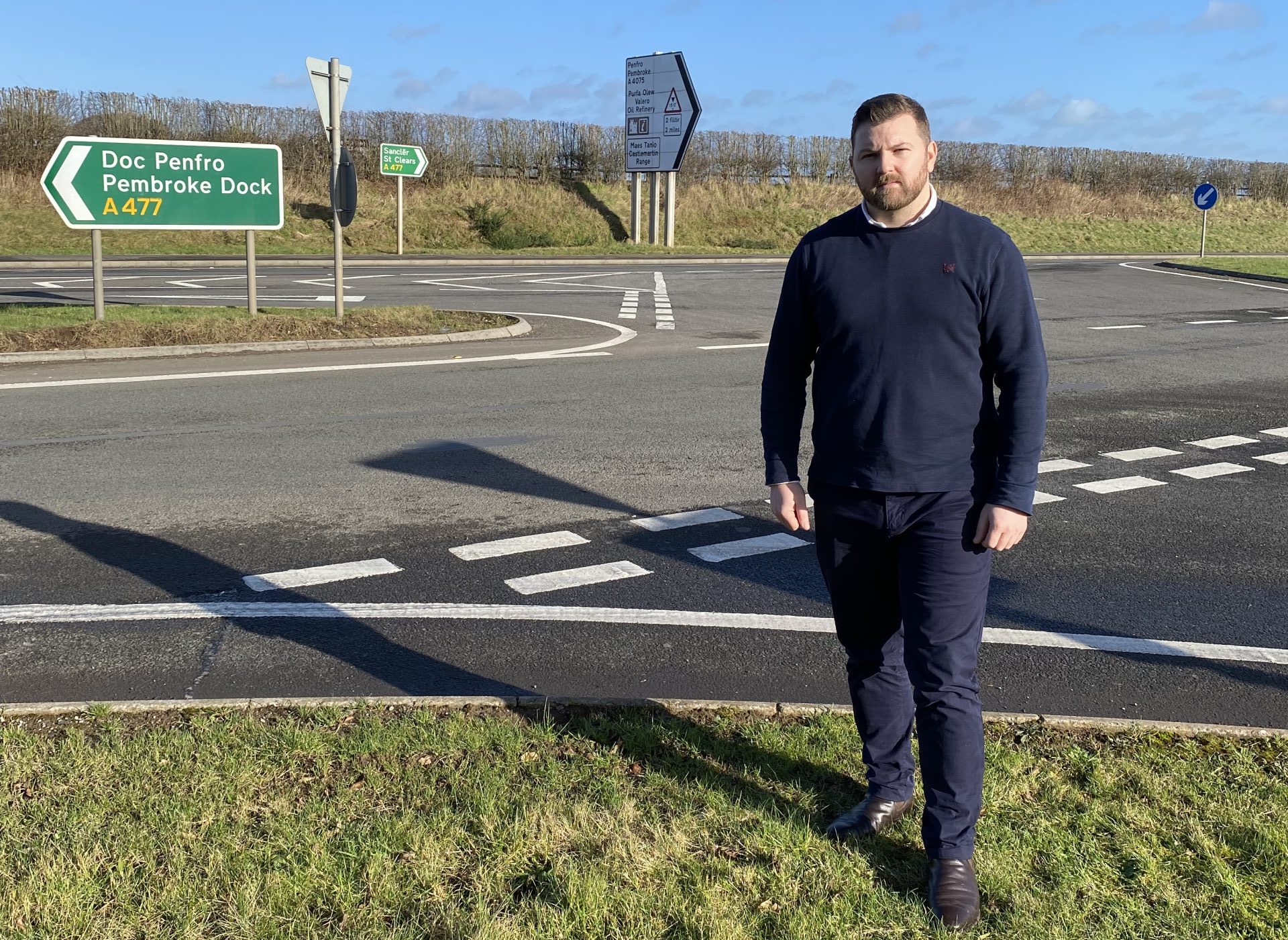
EFFORTS to improve road safety on a perilous stretch of road in Pembrokeshire are set to commence this month, with plans to install traffic lights at the infamous Nash Fingerpost Junction. This initiative follows persistent demands for safety enhancements by campaigners concerned about the junction’s hazardous conditions.
The Nash Fingerpost Junction, a notorious ‘black spot’ located at the intersection of the A477 and A4075 between Milton and Pembroke Dock, has been the site of numerous accidents over the years. The most tragic of these occurred in May last year, claiming the life of 29-year-old motorcyclist Ashley Rogers from Kilgetty.
In response to these incidents, local residents have intensified their campaign for significant modifications at the junction. Their efforts have included petitions urging both the Senedd and Highways Authorities to re-evaluate and redesign this busy juncture.
Senedd Member Samuel Kurtz for Carmarthen West and South Pembrokeshire has been a prominent advocate in pressing the Welsh Government to follow through on its commitments to these crucial safety upgrades.
Cllr Tessa Hodgson, representing the Lamphey ward, recently revealed details about the upcoming works. Scheduled to start on Sunday, May 19, and expected to conclude by mid-September, the project will involve the installation of new traffic light systems and enhancements to kerb alignments. Additionally, upgrades will be made to the existing active travel route. To facilitate these changes, contractors will work up to 12 hours a day from Sunday to Friday, between 7am and 7pm.
During the entire duration of the improvements, temporary traffic signals will be operational to ensure the safety of both motorists and workers on site. These measures are being overseen by the South Wales Trunk Road Agent (SWTRA).
The work will be briefly suspended during the summer embargo period from August 22 to 27, resuming thereafter until the project’s completion in mid-September. A spokesperson for the principal contractor has expressed apologies in advance for any potential traffic disruptions, although assurances have been given that efforts will be maximized to minimize inconvenience during the peak summer holiday period. Furthermore, there will be no traffic management activities during the Summer Bank Holiday weekend to ease travel disruptions.
This development comes as a significant relief to many in the community who have long voiced concerns about the safety of the junction, emphasizing the necessity of these enhancements to prevent future tragedies.
-

 Community7 days ago
Community7 days agoLucy’s sudden passing at just 38 leaves a community in mourning
-

 News3 days ago
News3 days agoCyclist dies during annual charity ride to Tenby
-

 News4 days ago
News4 days agoRenewed social media appeal over Sian Batchelor’s death
-

 News4 days ago
News4 days agoAurora Alert: Another chance to see the Northern Lights tonight
-
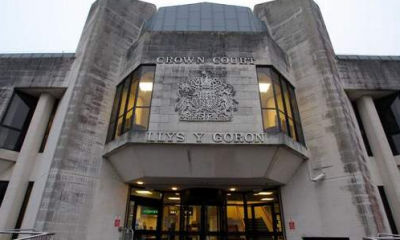
 Crime8 hours ago
Crime8 hours agoMilford woman ’caused significant life-changing injuries to motorcyclist’
-
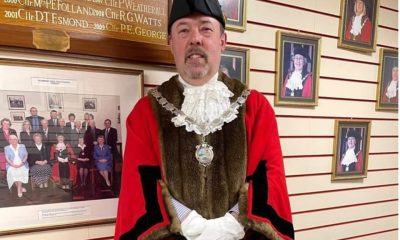
 Crime5 days ago
Crime5 days agoFormer Pembroke Dock mayor admits child abuse image charges
-

 Business6 days ago
Business6 days agoLidl will be first supermarket to sign up for milk from Pembrokeshire Creamery
-

 News1 day ago
News1 day agoSian Batchelor: Police issue new appeal for information












